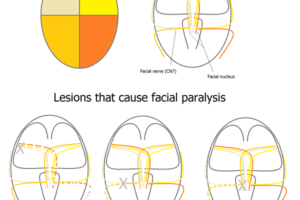VPM and VPL send projections up to primary somatosensory cortex, defined by Brodmann’s areas 3, 1, and 2 sitting on the post-central gyrus. Because all the somatosensory tracts are crossed (remember the different decussation points for the DC-ML, anterolateral and trigeminal systems), the somatosensory cortex has a detailed representation of the CONTRALATERAL surface of the body.
While areas 3, 1 and 2 are all typically considered primary somatosensory areas, Area 3 receives the bulk of projections from the thalamus so is more properly consider THE primary somatosensory cortex (S1). Areas 1 and 2 receive input from S1, and the receptive fields within these higher areas are more complex than what is observed in S1.
Sensory Homonculus
Just as there is a somatotopic map in the medial lemniscus and VP nuclei, the somatosensory cortex has a map of the body. In fact, it has multiple, mirror image maps, each responsive to different aspects of somatosensory inputs. The somatotopic map in S1 is called the homunculus (see figure) and is distorted by areas that have a high density of sensory inputs. For example, the back takes up a very small portion of S1, while the fingertips, face and mouth take up a disproportionately large area of cortex. This distorted representation is similar to that seen in visual cortex, where the fovea takes up a disproportionately large area of V1.
Receptive Field Structure and Lateral Inhibition
Each neuron in the somatosensory area responds to a small part of the body, this corresponds to the spatial outline of the neuron’s receptive field. The receptive field, however, is also determined by the type of information it receives (eg. Pain, temperature, proprioception, etc.), the level in the processing system (higher cortical areas have progressively larger receptive fields that integrate across multiple modalities), and the type of interactions among neurons.
One prominent type of processing of somatosensory information is lateral inhibition. Lateral inhibition takes place at several levels, starting in the spinal cord. Like the effect of the center-surround structure of retinal ganglion cell receptive fields, lateral inhibition acts to increase the contrast sensitivity of somatosensory neurons. That is, nearby neurons inhibit each other. If a sensory surface (like your fingers) pass over a smooth surface all peripheral neurons would be activated equally, but all would inhibit each other in the spinal cord. If, however, a small group of sensory receptors are activated by a small bump (say the F and J markers on your keyboard) but surrounding sensors are only weakly activated by the smooth area surrounding (say the full F or J key), then the strongly activated receptors would inhibit the responses of the neighboring receptors (in the spinal cord and higher) so that the signal from the small bumps are progressively accentuated up the sensory system. Effectively, lateral inhibition makes our brain ignore smooth surfaces but become highly sensitive to changes in surfaces.

